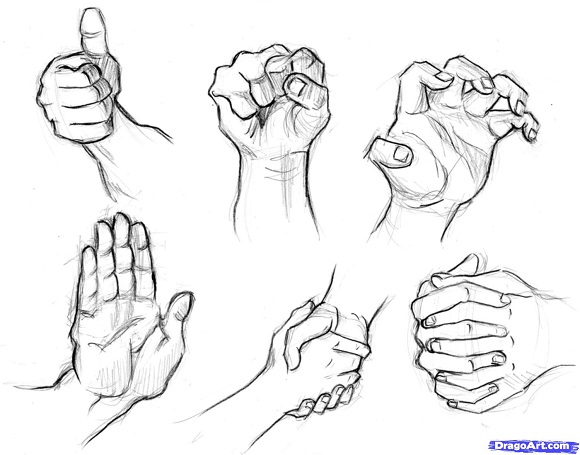4 ways to draw realistic hands
Table of Contents
Table of Contents
Are you struggling with drawing hands realistically? Look no further! Learning how to draw realistic hands can be a challenging and frustrating experience. However, with the right guidance and practice, you can master this essential skill and enhance your artwork.
Pain Points of Drawing Realistic Hands
Drawing realistic hands is difficult for many artists. It is common to struggle with proportions, shapes, and emotions conveyed through the hand. Many artists shy away from drawing hands altogether, but it is an essential skill to master if you want to elevate your artwork. Not knowing where to start, having little guidance, and practicing incorrect techniques can lead to frustration and lack of progress.
Answering the Target of Drawing Realistic Hands
Start by studying the basic anatomy of hands. Understanding the bone structure and how they connect will lead to a better understanding of how to draw them realistically. Find references, such as photographs or drawings, to help you visualize the different positions and angles. Practice basic shapes, such as circles and triangles, to help create the overall shape of the hand. Pay attention to the proportions and muscle groupings, and practice until you feel comfortable.
Summary of Main Points
Learning how to draw realistic hands is difficult, but essential for enhancing your artwork. Study basic anatomy and find references to help guide you. Practice basic shapes, proportions, and muscle groupings until you feel comfortable drawing hands realistically.
Drawing Realistic Hands: Study and Practice
There’s no shortcut to learning how to draw realistic hands. It takes practice and dedication. Don’t be afraid to study and dissect the anatomy of a hand. Understanding the bone structure, muscle groups, and overall shape can help you draw hands realistically. It’s also helpful to find references to help guide you. Using images or drawings of hands in different positions and angles can help you practice drawing different types of hands. Once you feel comfortable with the basic shapes and proportions, don’t forget to practice drawing hands in motion or conveying different emotions.
Using Shadows and Highlights to Create Realistic Hands
Shadows and highlights can play a significant role in creating a realistic hand. They help create depth, texture, and dimension. Consider the light source when drawing hands and where shadows and highlights fall. Don’t be afraid to use a darker pencil to create shadows on the underside of fingers or in areas where the hand is shadowed. Use a lighter pencil or an eraser to create highlights on the tops of fingers or where the light source hits the hand.
Understanding Hand Positions and Gestures
The position of the hand and the gestures they create can convey different emotions and meanings. Understanding how to draw hands in different positions and gestures is essential for creating realistic and visually interesting artwork. Practicing these poses and gestures can help you feel more comfortable drawing hands in different ways.
Adding Texture to Realistic Hands
Texture can help create dimension and interest in realistic hands. Use different strokes to create different textures, such as hatching, cross-hatching, or stippling. Experiment with different pencils and techniques to create texture that is unique to your style. Remember not to overdo it, and keep in mind the overall harmony of the artwork.
Question and Answer
Q: What is the most challenging part of drawing realistic hands?
A: One of the most challenging parts of drawing realistic hands is understanding the bone structure and how the fingers connect. It’s essential to study the anatomy of the hand to create a more accurate drawing.
Q: How can I improve my hand-drawing skills?
A: The best way to improve your hand-drawing skills is to practice consistently. Focus on studying the basic anatomy of the hand, find references and take the time to recreate them. Don’t forget to practice drawing hands in different positions and gestures.
Q: Should I outline the fingers or start with the central shapes?
A: It’s best to start with basic shapes, such as circles and triangles, to create the overall shape of the hand. Focus on getting the proportions and angles correct before adding detail.
Q: What techniques should I use to create textures on hands?
A: Different techniques can create textures on hands, such as hatching, cross-hatching, or stippling. Experiment with different pencils and techniques to find what works best for you.
Conclusion of How to Draw Realistic Hands
Drawing realistic hands can be a challenging and frustrating experience, but with the right guidance, practice, and understanding of basic anatomy, you can improve your skills. Remember to take it one step at a time, focus on basic shapes and proportions, and practice consistently. Studying different hand positions, gestures, and understanding textures and shadows can add depth and interest to your artwork. Keep practicing, and before you know it, you’ll be drawing realistic hands like a pro.
Gallery
Sketch | Realistic Drawings, How To Draw Hands, Online Drawing

Photo Credit by: bing.com / realistic hands draw drawing drawings step hand sketch pencil dragoart wrist tutorial sketches techniques catlucker some portraiture added charcoal realism
How To Draw Realistic Hands Step By Step For Beginners

Photo Credit by: bing.com / hands beginners doitbeforeme
How To Draw A Realistic Hand - YouTube

Photo Credit by: bing.com / realistic hand draw
4 Ways To Draw Realistic Hands - WikiHow

Photo Credit by: bing.com / wikihow
Best Collection Of Step By Step Tutorials On How To Draw Hands

Photo Credit by: bing.com / hands draw step drawing realistic hand tutorial drawings tutorials holding easy human cartoon reference learn collection expressive manga yourself very
